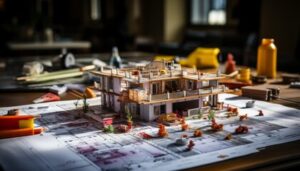General Contractors Lexington KY are not just project overseers anymore. They now serve as innovation filters and conflict absorbers. With increasing demands for efficiency and flexibility, their skillset has expanded. They’re expected to think like designers, engineers, and even marketers.

The line between planning and execution continues to blur. General contractors today must anticipate unseen problems before they surface. They operate in a digital maze of simulations, budget forecasts, and client revisions. Their success lies in adapting fast to what can’t be predicted.
Smart construction has elevated expectations. Wearables, drones, and sensors are now part of a general contractor’s daily toolbox. They interpret data on material stress, worker safety, and productivity. This real-time insight changes how decisions are made on-site.
Gone are the days when blueprints were static. Now, general contractors work with fluid digital models that constantly change. These living documents are shaped by multiple collaborators. Each update must be processed and implemented with zero delay.
Budget control remains central, but its complexity has multiplied. Material prices fluctuate unpredictably, and shortages appear overnight. General contractors act as economic forecasters, hedging against volatility. Their choices can make or break an entire project.
The human side of construction is also under their watch. Hiring skilled labor while ensuring diversity and compliance is challenging. Contractors now engage in talent nurturing, not just supervision. They balance output with wellness to avoid burnout on-site.
Green building regulations are shaping how contractors think. They must select sustainable materials without inflating costs. Every choice must meet energy benchmarks and environmental codes. Failure to comply affects more than reputation—it halts progress.
Contractors today speak multiple technical languages. They must collaborate with AI modelers, structural engineers, and urban planners. Miscommunication can cost weeks, so translation between specialties is key. This demands a blend of logic and empathy rarely expected before.
Client expectations are now layered with social influence. Contractors often find themselves responding to online opinions and community feedback. Virtual tours and live progress updates are standard. Transparency isn’t optional anymore—it’s a demand.
Legal landscapes have also shifted. Contractors are now more exposed to liability from remote stakeholders. Each step must be documented to the micro-detail. Contracts need to be agile yet protective, able to withstand unexpected shifts in scope.
Contractors are becoming gatekeepers of trust. Their decisions affect lives, safety, finances, and long-term structural reliability. Mistakes are captured and criticized instantly. So, risk assessment has moved from the background to center stage.
Scheduling involves more than sequencing tasks. It now includes buffers for digital approvals, third-party verifications, and weather analytics. Smart tools help, but the contractor still shoulders the final responsibility. Accuracy and realism must work together.
There is rising pressure to build faster and smarter. Modular and offsite construction methods are gaining momentum. Contractors need to synchronize factory timelines with on-site realities. Misalignment leads to gaps, waste, and client dissatisfaction.
Digital twins are influencing how contractors visualize outcomes. These virtual mirrors of physical spaces allow error-testing before actual construction. They reduce surprises but require deep interpretation. Contractors must balance simulation with human intuition.
Crisis management has become a refined skill. From weather interruptions to political unrest or supply chain failures, disruption is expected. The best general contractors don’t just recover—they pre-position alternatives. Preparedness is part of their core DNA.
Design decisions often fall to contractors in real-time. Field conditions sometimes override plans, calling for spontaneous solutions. These micro-decisions require both creative and structural understanding. They are judged just as much as major choices.
Training is no longer just about safety and tools. General contractors undergo leadership, emotional intelligence, and conflict resolution education. They must mediate tensions between workers, consultants, and clients. Their emotional footprint now influences productivity.
Digital documentation is a growing workload. Every task, material, and change is logged for audit trails and compliance. While tools automate some of this, oversight still demands human accuracy. This data eventually feeds into future project predictions.
Cultural sensitivity is another overlooked but vital skill. With global teams and diverse labor forces, contractors manage unique expectations. Even break times, communication styles, and problem-solving vary. Inclusion and respect must be built into daily routines.
Technology fatigue is a real challenge. New platforms promise efficiency but can overwhelm if misused. Contractors must discern which tools add clarity and which create noise. Their digital mindset becomes as crucial as their practical instinct.
Real-time cost tracking has changed accountability. Clients now demand access to financial dashboards at every phase. The pressure to justify each dollar has never been higher. Budget transparency must be delivered without losing financial control.
Contingency planning is no longer optional. Smart general contractors now embed multiple response plans per phase. These aren’t pessimistic—they’re strategic. When uncertainty becomes routine, preparation becomes a strength.
Contractors are judged not just by completion, but by how the journey feels. Did they communicate well? Were updates timely and transparent? Did the team feel safe and empowered? These soft factors shape reputation more than metrics alone.
Preconstruction has become a battleground of influence. Contractors must now be involved from the earliest design stages. This allows better alignment and realistic estimates. Late involvement often leads to friction and redesigns.
The rise of virtual site inspections has increased efficiency. However, it adds pressure for hyper-clean digital organization. Poor virtual presentations reflect badly on contractor professionalism. Every detail seen through a camera becomes a lasting impression.
Community engagement is a quiet but growing responsibility. Construction projects now require social alignment with nearby residents. Noise, access, and environmental impact are scrutinized. Contractors often act as public relations agents for their projects.
Sustainability reporting is now embedded in project closure. Contractors provide detailed logs of material sourcing, energy usage, and waste management. These reports influence certifications, funding, and future opportunities. They can’t be faked—they must be earned.
Technology has made mistakes harder to hide. Drones, AI cameras, and smart sensors capture everything. This has driven a culture of responsibility. Every decision, even small ones, leaves a digital trail.
The role of general contractors is also changing financially. Payment models are shifting toward performance-based systems. Bonuses and penalties depend on meeting not just time, but quality and safety benchmarks. It aligns incentives but increases stress.
Contractors must now be brand ambassadors for their firms. They represent reputation at ground level. Their conduct, communication, and responsiveness affect future projects. Personal behavior now ties directly to professional opportunity.
Innovation labs are quietly influencing contractor workflows. Experimental materials, AI robots, and new energy systems need practical testing. Contractors bridge the gap between research and reality. They prove what works under pressure.
Virtual collaboration is now embedded in the workflow. Contractors must lead teams spread across time zones. Coordination tools reduce confusion, but only if used well. Clarity and consistency in communication have become a survival skill.
The younger workforce wants purpose, not just pay. Contractors are challenged to build cultures that inspire, not just instruct. They must coach, listen, and celebrate small wins. Leadership has become more human.
Micro-learning is redefining on-site education. Training videos, apps, and QR codes offer just-in-time instruction. It keeps workers sharp without slowing progress. Contractors must curate and monitor this knowledge flow.
Material innovation is reshaping logistics. Self-healing concrete, recycled composites, and climate-adaptive materials demand new handling techniques. Contractors must evolve or risk costly mistakes. Adaptation is no longer optional—it’s expected.
General contractors hold the last line between design and reality. They translate drawings into durability. In every foundation poured or beam installed, their judgment lives on. As the built world grows smarter, so must they.
